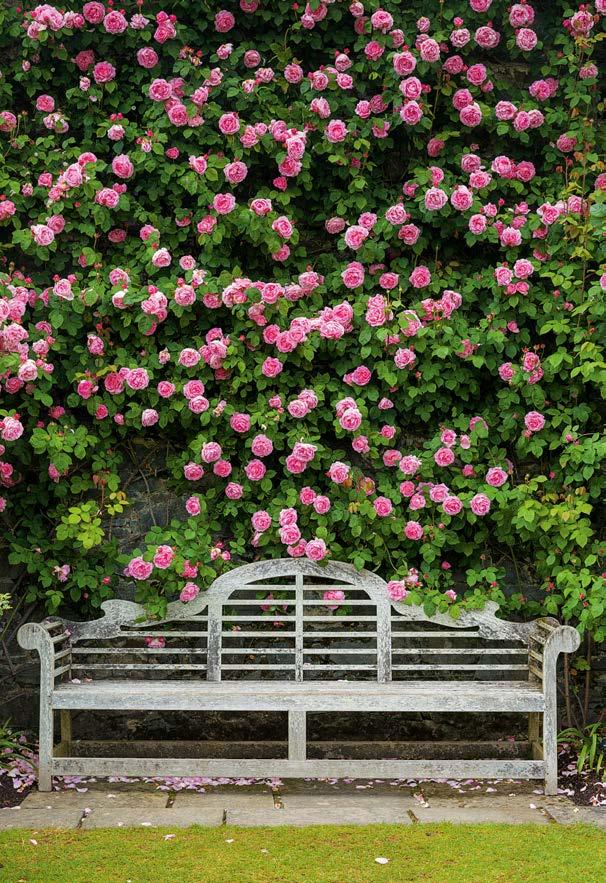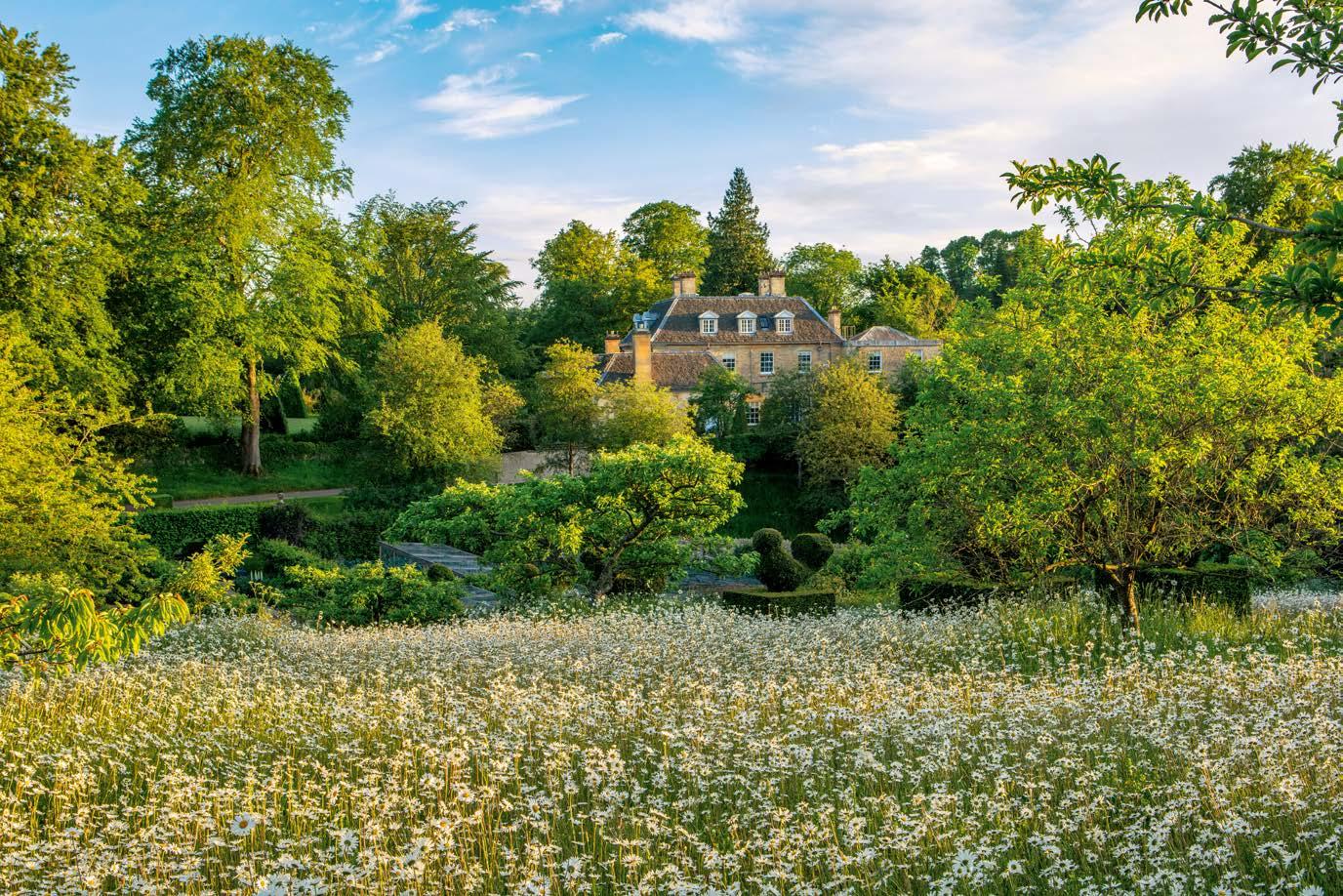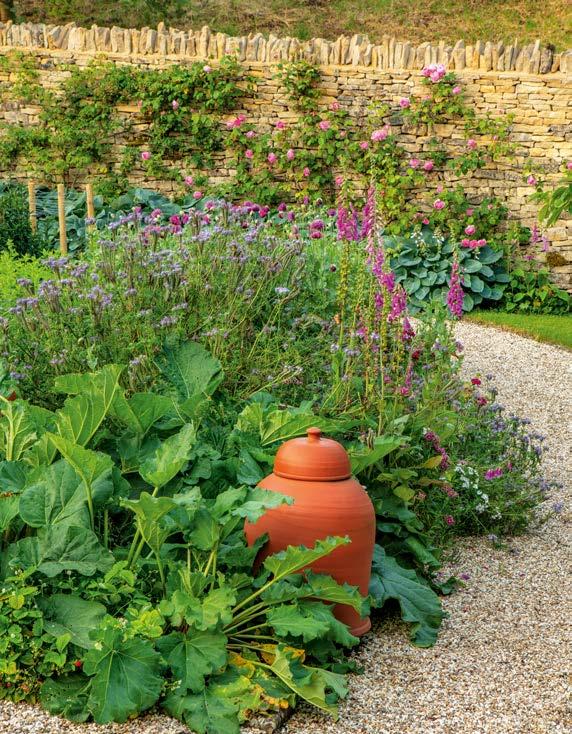
18 minute read
Bodnant This iconic estate in North
THE NEW WAY
Bodnant in North Wales features some of the most stunning landscaping of its era and paved the way for a new model of funding and visiting gardens
WORDS IONA McLAREN PHOTOGRAPHS JOE WAINWRIGHT
Snowdonia is one of the wildest and most inhospitable parts of Britain. When you’re amid its rock faces, scree slopes, black lakes and eerie tawny valleys, civilisation can feel very far away. It is, therefore, something of a surreal surprise for climbers to spot, staring back at them from across the River Conwy, a distant cascade of Italianate terraces, conceived on gigantic scale.
The gardens at Bodnant, which were given to the National Trust in 1949 and now attract more than a quarter of a million visitors a year, are a theatrical spectacle unrivalled in British horticulture. Even without the garden, the setting is truly jaw-dropping. Down below is a lazy, fat, silver bend of the mighty Conwy, as it broadens into the estuary guarded by Conwy Castle, while beyond that sprouts a blue wall of high mountains in the Snowdonia National Park.
Then there is the garden itself – Grade I listed and the creation of many generations of the same family. Ranging over 80 acres, with seven miles of paths, its mood changes from plunging cliffs, churning falls and giant redwoods to dreamy formal canals and balustrades – an exhilarating marriage of classical and gothic. It is an architect’s garden, and a plantsman’s garden, too, home to countless rare specimens and five national collections – of magnolias, embothriums, eucryphias, Rhododendron forrestii and Bodnant hybrid rhododendrons – as well as around 40 of the British Isles’ champion trees. As the garden writer H. Avray Tipping put it in 1920: “Bodnant is a spot where a complete garden education can be received.”
So how did it come to be, in this least likely of places? Once there was a white Georgian house at Bodnant, which stared steadfastly across its own Capability Brown-esque parkland, the majestic beeches and oaks of which form the backbone of the garden today. Pointed away at a right angle, the
original house oddly ignored the now-famous view of Snowdonia: an excess of the sublime perhaps being thought bad for the digestion.
Things changed when the Bodnant Estate was bought in 1874 for £62,500 by Henry Davis Pochin, a self-made man of magnificent and cheerful vulgarity, whose fortune came from his invention of white soap, and increased with speculations in railways and coal. The embodiment of the Victorian era, with mutton chops, rotund belly, radical Liberal views, boundless energy and a thirst for the Gothick, Pochin did nothing by halves.
Within a few years, the white Georgian mansion – an anaemic provincial affair – had disappeared inside an excrescence of blue sandstone and halftimbering, complete with armorial stained glass. Mark Girouard, in The Victorian Country House, categorised it as “dim and grim Old English”; in The Rise of the Nouveaux Riches, J. Mordaunt Crook called it “the ugliest house in England”, which is perhaps untrue only insofar as it is not in England.
Pochin’s interventions in the garden were just as grandiose, but far happier in effect. For an architect he had employed an unknown, but for his landscape design he chose the well-known Edward Milner, Joseph Paxton’s apprentice at Chatsworth, then his superintendent of works at Crystal Palace. Milner’s plan transfigured the Regency parkland at Bodnant, encircling the house with something more formal, including a terrace and a Dutch flower garden, and making the wilder bits of the garden more wild, with a pleasure-ground rockery added for alpines.
It was, in the words of Pochin’s grandson Harry, the second Lord Aberconway, “a very quiet, restful, reposeful garden” of “great spreading lawns under big trees”. Pochin made the famous Laburnum Arch, the longest in Britain, and down in the garden’s steep valley, or Dell, he began his pinetum, planting prime


Top left Rosa ‘Princess Anne’ with groundcovering Campanula portenschlagiana. Above Stone steps navigate the terraces via rose-festooned arches. Left Elegant Aquilegia ‘Yellow Queen’. Right Views to the Carneddau mountains from the garden.


specimens of Abies veitchii, Cedrus deodara, Tsuga mertensiana, Sequoiadendron giganteum, Sequoia sempervirens and so on. These giants now soar above the Wagnerian clifftop mausoleum, known as The Poem, which Pochin built above his swan pond and in which, in 1895, he was laid to rest.
When he died, Pochin left his industrial empire and Welsh estate to his daughter Laura, his son, Percy, having been disinherited after a series of scandals involving unsuitable marriage and the abuse of a page boy. Laura was a formidable woman – already treasurer of the London branch of the National Society for Women’s Suffrage by the time


she was 30 – and described by The Harry McLaren Times in her 1933 drew up five obituary as “one of the foremost great terraces, horticulturists in Europe”, as well as “a capable woman to be executed in masonry with of business, with the ready grasp stone quarried and the courageous nearbypower of decision that enabled her to weigh big problems with the brain of a man”.
She loved flowers, and needed more places in the garden to plant them. Her 23-year-old son, Harry, conceived the idea of carving the great, bare western slope of the garden into a series of Italianate terraces. What happened next is one of the great wonders of British gardening. With no formal training, but dreaming of the Italian gardens he had seen on his travels, this young man drew up five great terraces, to be executed in masonry with stone quarried nearby. Sir Eric Savill, creator of the Savill Garden in Windsor Great Park, would later call it “the finest work of garden design this century in this country”.
Almost as remarkably, Harry’s mother let him realise his plans. She “sent her men and masons there” and entrusted to him, by then aged 25, “all the work of terracing… and with it all the detailed work of the garden”. It was, he said, “a magnificent gift – an unusual and great gift”. “It changed my whole life. There are not many people who have had the advantage of having a great garden handed over to them at that age with liberty to do what they liked with it within reason, and funds generously available to do all that they wished.”
With the energy of youth, Harry – later Lord Aberconway, and RHS President between 1931 and 1953 – went on to transform the garden, turning it into a horticultural showcase for thousands of the latest discoveries of Edwardian plant hunters: rare magnolias, primulas, gentians, the handkerchief tree. Even though he was counselled that rhododendrons wouldn’t “do” in north Wales, he tried the Chinese and Himalayan varieties brought back by Ernest ‘Chinese’ Wilson – and found they did remarkably well. Soon, Harry was sponsoring his own plant-hunting expeditions, and even running a private band of collectors in Yunnan via an obliging British consul in Burma.
His exceptionally green-fingered head gardener, Frederick Puddle, began hybridising Top Glorious Cornus rhododendrons, and kousa ‘Milky Way’. Bodnant varieties were Left The garden is known for its rhododendron soon taking prizes at collection; this is pinkChelsea – Harry being flowered R. ‘Vanessa Pastel’.
An arch through to the vegetable plot is covered with Clematis ‘Étoile Violette’ and pink rose ‘The Generous Gardener’.



Above Rosa glauca presides over a border of meadowy perennials. This image Wisteria drips over Italianate stonework. Left A quiet spot on the rose terrace, the wooden bench backed by Rosa ‘Constance Spry’.

TRADITIONAL WORKWEAR FOR MEN AND WOMEN

carriercompany.co.uk +44 (0)1328 820699


Top One of Bodnant’s most recognisable features, the famous Laburnum Arch. Above The view of Bodnant Hall over the Lily Terrace’s still pond. Right Rosa ‘Phyllis Bide’ fades to blush white. most proud of R. Elizabeth, First Class Certificate winner in 1943, which, he pointed out, “has more flower buds on it than any rhododendron you can grow” and was suitable for the “smallest possible garden”. Some 300 rhododendron hybrids were registered to Bodnant and there are still over 100 Bodnant varieties in the garden, some existing only as a single specimen.
All this time, the garden was open to visitors with proceeds from the tickets sold going to support district nurses. At one Chelsea Flower Show in the 1930s, Harry’s wife Christabel told the King of a recent visit to Bodnant by the Prince of Wales, the future Edward VIII, where “he had walked all round the garden, shown a deep interest in all the rhododendrons, had talked with gaiety at dinner, and finally having gone up to his bedroom, after this gruelling day, for over half an hour had played the bagpipes”. The King, instead of being impressed at his son’s vitality, turned to Queen Mary and said: “Your son has been playing the bagpipes in Wales.”
In 1949, Harry, as chairman of the National Trust’s garden committee, handed Bodnant to the nation, to encourage other stately homeowners. “It begins to look as though many of our most lovely and historic gardens would deteriorate from lack of upkeep,” he said. “However energetic a worker you



Above Roses billow over may be yourself, it is the paths of the Lower physically impossible Rose Terrace, providing continuous flushes of for one pair of hands colour from June. to keep weeds from Left Hot colours in the encroaching, to clip Range Borders, which hedges, to mow lawns, vary every year. and do the thousand jobs that a garden of any size demands.” Seventy-two years later, with its team of over 20 full-time gardeners, plus volunteers, and under the care of the National Trust and Harry’s grandson, Michael McLaren, Bodnant now looks better than ever.
The story of Bodnant thus tells, in microcosm, the story of garden design, and garden visiting, in Britain. It was the creation of gifted amateurs, and has delighted and inspired millions more. As Harold Nicolson put it, when he visited in 1952, “I have no doubt at all that this is the richest garden I have ever seen… one of the wonders of the world.” n
Bodnant Garden, Bodnant Road, Tal-y-cafn, Colwyn Bay LL28 5RE. Open all year, but visits must currently be pre-booked – check the website for updates. Tel: 01492 650460; nationaltrust.org.uk. Bodnant Garden by Iona McLaren is published by Pavilion Books (£16.99).
Forward PLANNING
If you want to enjoy a lavishly planted mature garden, get going on it while you’re young. Emma and Simon Keswick did just that at their Cotswold garden, Rockcliffe, and now they’re reaping the ample rewards as they luxuriate in their dream garden
WORDS JAMES ALEXANDER-SINCLAIR PHOTOGRAPHS CLIVE NICHOLS

Hardy geraniums, astrantia, catmint, thalictrum and roses make a co-ordinated display in this generous mixed border.

Colourful borders lead the way to Rockcliffe’s impressive focal point, the Dovecote, reached via steps flanked by yew topiary birds.

There is an ancient saying about (and I generous branches of Cornus controversa ‘Variegata’ paraphrase massively here) gardeners and from there we wander off into a world of blissful planting trees under whose shade gardens. There are deep herbaceous borders, marked they will never sit. This is generally by four Irish yews that were obtained from a small considered forward thinking, wise ad in the Evesham Journal: the Keswicks had to and selfless and, as such, should be applauded. go and dig them out of the vendor’s garden. Also But my counter theory is even wiser. Make sure a pink garden, a pool garden, knobbly pleached that you plant a load of trees, shrubs, hedges and limes, a croquet lawn and even a playground for the topiary when you are young so that 40 years on you grandchildren. Patches of wildness nudge against can look up to their branches and wander through carefully trimmed hedges of the evergreen stalwart, gardens you have watched grow and flourish. Such yew (Taxus baccata) as well as beech and hornbeam, is the happy situation at Rockcliffe: a garden in the while chess pawns clipped from yew mark the path Cotswolds started in the 1980s by Emma and Simon junctions. On the shady margins of the garden is the Keswick and gardened by them ever since. Martagon Walk where, for 20 years, Emma has been
When they arrived there was not much beyond a scattering the seeds of turk’s cap lilies. Last year she house and some surrounding fields: one side of the collected 400 grams of seed, so it just keeps getting house is set hard against the boundary and a steep better. This is a beautiful lily, native to the alpine hill, so Emma marked out the garden by marching meadows of Switzerland, entrancing en masse. eastwards, pacing out the main view from the house. The kitchen garden is tucked into a small ravine She knows her onions (having done courses at and surrounded by high stone walls. One of the Merrist Wood and The English Gardening School) mixed blessings of living in the Cotswolds is the and walked out to where the proportions seemed abundance of gorgeous soft yellow stone: it looks right. She then decided to add another 20 metres amazing in field and house walls, but it’s not so of field so that there was space for “a really good much fun when you’re trying to dig a border! The garden”. They then built a ha-ha to keep out the soil is free-draining but needs a lot of barrowed sheep and set about planting a series of gardens muck to give it the oomph to produce vegetables within gardens to make up the many-layered, and cut flowers for the house. The kitchen garden surprising setting that we see today. beds used to be box edged until the Inspiration at Rockcliffe comes from a Below A weathered, inevitable blight arrived; now they are multitude of places – as Emma herself lichen-encrusted tree seat is the embodiment all enclosed in mesh cages edged with maintains: “The ideas have to come of Rockcliffe’s mature, fretwork boards and carved finials. from somewhere!” settled atmosphere. At first glance this seems a puzzling
A wide lawn leads construction: are they from the house towards producing industrial the ha-ha and a fine quantities of soft fruit? sculpture by Nigel Hall. Or are the Cotswold It is flanked by massive courgettes particularly beech obelisks cleverly aggressive? Look up the planted in lines that hill and the answer is are not quite parallel obvious: doves. Beautiful in order to give the birds but not exactly impression that the perfect companions vista is even longer. “It to vegetables. is an idea that I saw in The stone Dovecote the Palazzo Corsini in is approached from the Florence where they kitchen garden via a achieve the same effect path edged with plump with statues,” Emma borders and backed by recalls. The stone terrace espalier-trained medlars is broken by hummocks (Mespilus germanica, of yew interplanted with which have the prettiest a rattle of herbaceous blossom of any fruit tree plants to bring in colour although, entre nous, and texture. This wraps the fruit can be a little around the house to annoying: lots of work a handsome orangery for a few jars of jelly). and a rectangular pond Through the trellised that is canopied by the white door there is a

Topiary birds on crisp blocks of yew mark the steps to the Dovecote, a project to celebrate the turn of the millennium.


steeply sloped orchard with wide grass steps alongside which a series of topiary birds perch, having slowly gained shape and heft over a number of years. The topiarised yews lead the eye to a focal point that was crying out for a statement and so, after much research, a delightful building was constructed. This is Emma’s millennium project so it has had time now to mellow beautifully. “It is an amalgamation of various places: the dovecote at Rousham, the weathervanes from Eton College Chapel, windows from the Gothic Cottage at Stourhead and stonework from the Old Toll House in Stow-on-the-Wold,” she explains. In summer, both Dovecote and topiary float on a romantic billow of ox-eye daisies. The doves, meanwhile, flutter about looking decorative and innocent, while coldly eyeing up the brassicas.
The newest part of the garden is the developing Sorbarium. This is not a term with which I am familiar, perhaps because it was invented at Rockcliffe and constitutes a collection of rowans
Top Perfect stripes and beech pyramids lead the eye from the terrace to a sculpture by Nigel Hall. Above Moisture-loving Iris sibirica ‘Silver Edge’. Right Yew hummocks add a weighty element to blowsy planting next to the terrace.




(Latin name Sorbus) assembled in honour of Simon Keswick’s Scottish roots. The rowan is steeped in folklore. People planted them by their houses as symbolic protection and, even today, Scottish gardeners are very reluctant to damage a rowan. Here, Emma has created a box-edged grass path that meanders and swerves through swathes of wildflowers studded with Sorbus specimens. The trees will have their hour of glory come autumn, when the leaves change and the berries develop but, in the meantime, there are stands of Rosa ‘Cerise Bouquet’. This rose is neither coy nor retiring: it is unashamedly bright, blowsy and full of puff. With arching sprays of flowers as pink as a go-go dancer’s petticoats, it is a tough old thing that copes with rubbish soil and a bit of shade. Judging from the evidence, therefore, a Sorbarium is an arboretum with a lot of attitude.
This is a big garden that has been made slowly and with love over the past four decades and, as a result, it has an atmosphere of comfortable familiarity that,
Top Looking back to the house from the opposite slope, the building seems to float above a sea of daisy-filled meadow. Above For similar poppies, try Papaver somniferum ‘Dark Plum’. Left Spires of foxgloves march up the border.

Above Bespoke oak cloches protect crops in the kitchen garden with a Victorian-style greenhouse from Alitex and espaliered fruit.

even as a first-time visitor, you can feel. It is not an easy place to garden as the soil is Cotswold brash (Emma is particularly keen that I view the orderly and well-kept compost heaps that feed the hungry earth). The winds can bite and the frost at this altitude (550 feet above sea level) hangs about well into the spring. It is gardened beautifully (currently there are three gardeners) as can be seen everywhere from the artfully pruned roses to the razor-edged hedges. That said, Emma’s stated intention all those years ago was to give herself enough space to create a “really good garden” and that is precisely what she has done. Really, really good. n
Rockcliffe, Upper Slaughter, Cheltenham, Gloucestershire GL54 2JW. The garden should open for the National Garden Scheme on 2 and 30 June, but visit ngs.org.uk or rockcliffegarden.co.uk for more information and updates.
Top Rosa ‘Cerise Bouquet’ emerges from a haze of ox-eye daisies in the Sorbarium. Above Lilium regale on the terrace by the house. Right Rhubarb in the vegetable garden, which is surrounded by high, Cotswold stone walls.


Save over £15 a year o the shop price
THE

ARDENG english


APRIL 2021
For everyone who loves beautiful gardens
www.theenglishgarden.co.uk
Time for TULIPS



Spring’s brightest bulbs put on a show

FREE delivery to your home
Wisteria made easy



How to grow this glamorous climber
Raymond Blanc’s top 10 vegetables to sow now
The beauty of April
● RARE PLANTS at Cally Gardens ● How to divide PERENNIALS ● Guide to garden BUILDINGS ● Creative projects for EASTER
£4.95 Plus a FREE GIFT*
Cover3_Apr.indd 1
* Spear & Jackson secateurs available to UK annual Direct Debit subscribers only

2/11/21 6:18 PM
Order your subscription today
Subscribe to The English Garden for just £42.95 for 13 issues and save 28% Visit www.chelseamagazines.com/CTEGJN21 or call +44 (0)1858 438 833 quoting CTEGJN21











